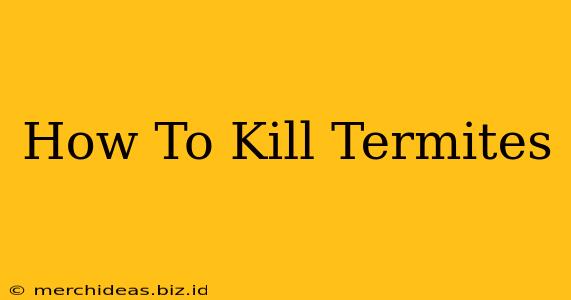Termites. The mere mention of the word sends shivers down the spines of homeowners everywhere. These silent destroyers can wreak havoc on your property, causing thousands of dollars in damage before you even realize they're there. But don't despair! This comprehensive guide will equip you with the knowledge and strategies to effectively eliminate these wood-munching menaces and protect your home.
Identifying a Termite Infestation
Before you can kill termites, you need to know you have them. Early detection is crucial in minimizing the damage and cost of treatment. Look for these telltale signs:
- Swarmers: These winged termites emerge during mating season. Finding discarded wings near windows or doors is a strong indicator of an infestation.
- Mud Tubes: These protective tunnels are built by subterranean termites to travel from the ground to wood sources. Check the foundation of your home, especially around cracks and crevices.
- Damaged Wood: Look for hollow-sounding wood, especially in wall areas or flooring. If you can easily push a screwdriver into the wood, you may have a termite problem.
- Frass: This is termite droppings, which resemble tiny pellets of sawdust.
Methods to Kill Termites
There are several approaches to termite control, ranging from DIY solutions for small infestations to professional treatments for larger, more established colonies.
1. DIY Termite Treatments (For Small Infestations Only)
Important Note: DIY treatments are generally only effective for very small, localized infestations. For larger infestations, professional help is strongly recommended.
- Boric Acid: This naturally occurring substance is toxic to termites. You can purchase boric acid powder and apply it directly to affected areas, but be cautious as it can be harmful to pets and humans if ingested. Always follow product instructions carefully.
- Diatomaceous Earth (DE): DE is a fine powder made from fossilized diatoms. It's abrasive and can dehydrate and kill termites upon contact. Apply it liberally to affected areas. Again, be mindful of safety precautions.
- Neem Oil: This natural insecticide disrupts termite development and can be effective as a preventative measure or for small infestations. Apply it directly to wood surfaces.
2. Professional Termite Treatments
For significant infestations or to ensure complete eradication, professional termite treatment is essential. Professionals employ various methods including:
- Liquid Termiticides: These chemicals are injected into the soil around your home to create a barrier, preventing termites from accessing wood structures.
- Baiting Systems: These involve placing bait stations containing slow-acting termiticides that termites carry back to the colony, effectively eliminating the entire population.
- Fumigation: This is a more extreme measure used for severe infestations and involves treating the entire structure with a gas to kill termites. This requires extensive preparation and evacuation of the home.
Preventing Future Termite Infestations
Once you've dealt with an existing infestation, preventative measures are crucial to avoid future problems.
- Proper Moisture Control: Termites thrive in damp environments. Repair leaky pipes, gutters, and downspouts to keep moisture away from your home's foundation.
- Regular Inspections: Conduct regular inspections, at least annually, to check for signs of termites. Pay close attention to areas prone to moisture accumulation.
- Wood-to-Ground Contact: Minimize direct contact between wood and soil by creating a barrier between them.
- Maintain Landscaping: Keep vegetation and mulch away from the foundation of your home.
Conclusion
Dealing with a termite infestation can be daunting, but with the right approach, you can effectively eliminate these pests and protect your valuable home. Remember, early detection and appropriate treatment—whether DIY or professional—are key to success. Don't hesitate to contact a qualified pest control professional for assistance if you suspect a significant termite infestation. Early intervention is the best defense against costly repairs and extensive property damage.
